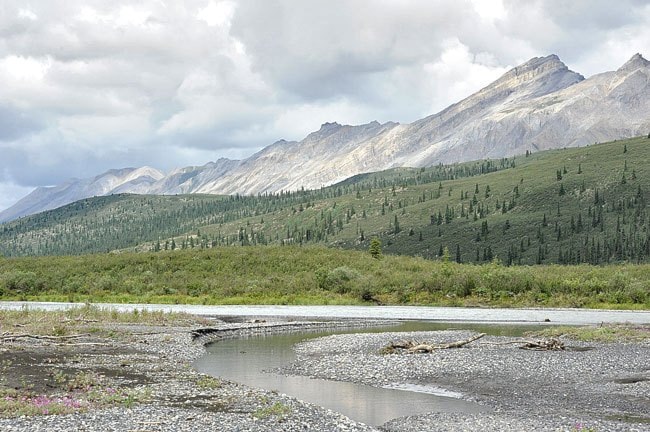At the heart of the Peel debate are roads.
Miners need them to haul out valuable rock. Conservationists oppose them for fear that they’d spoil the watershed’s remote wilderness.
Planners, who propose protecting four-fifths of the Peel, have offered up the hope that technology could break this deadlock. Especially promising was Boeing’s Skyhook.
Part blimp, part helicopter, the vehicle was designed with the idea of supplying remote northern mines. It would carry 40 tons of payload as far as 370 kilometres without refuelling.
The helium-buoyed machines were to hit the market in just a few years.
But the Skyhook project has quietly deflated. Boeing planned to build the vehicles in partnership with Skyhook International, a privately held Calgary company that was supposed to raise the project’s cash.
The global financial crisis punctured these plans. Skyhook International appears to have tanked: the company’s phone lines are disconnected and its website has disappeared.
And a Boeing spokesperson says the company’s no longer involved with the project.
Skyhook wasn’t the only hybrid blimp being developed for remote mines. Lockheed has teamed up with a private, Calgary-based company to launch a similar vehicle to supply Alberta’s oilsands. A small version is dubbed the Skytug, while a larger model is called the Skyfreighter.
But it’s far from clear that the high-tech blimp business will float. So, for the Peel, there’s probably a need for more down-to-earth solutions.
The proposed plan would ban roads to the bulk of nearly 11,000 mineral claims in the region. The Yukon Chamber Of Mines has protested that doing so would make these claims “worthless.”
Miners also argue that a ban on roads tramples on their right to access, and that doing so may result in a tangle of lawsuits.
But a miner’s right to access his claim isn’t clearly defined in Yukon law, said Jesse Devost, a spokesperson for Energy, Mines and Resources. There are certainly no guarantees miners can build roads.
To do so, they must apply to the Yukon Environmental and Socio-economic Assessment Board, and wait for the government to make a final decision.
These applications have been denied in the past. Karen Baltgailis, executive director of the Yukon Conservation Society, points to three prominent cases.
One involved the Rusty Springs mineral claim, just outside Fishing Branch Territorial Park. Miners wanted an access road through the park to truck out silver, lead and zinc, but were turned down.
Another case involves Joel White’s Horn claims within Tombstone Territorial Park. White’s plans to use snowmachines and helicopters to search for gold were rejected last autumn, for fear the operation would tarnish the park’s iconic image.
And Cash Minerals wanted to build an airstrip near the Wind River, within the Peel Watershed, to aid its hunt for uranium. In the winter of 2008, the territory shot down the plan.
Miners didn’t drag the territory to court in any of these cases. So Baltgailis is skeptical of the huffing and puffing over potential lawsuits in the Peel.
“Mining companies should not be surprised if they don’t get what they think is reasonable access,” said Baltgailis.
The strength of a miner’s claim to access would likely increase if they sat on a deposit that’s proven to be economically viable, said Baltgailis. But no Peel claims have reached that point, she said.
The current mess is of the government’s own making, Baltgailis noted. In 2004, when land-use planning talks began, the territory was encouraged to ban the staking of new claims in the region.
The government refused. And, predictably, prospectors rushed in.
Claims in the region jumped from 2,071 in 2004 to 10,666 in 2008. Most of the staking rush occurred along the Wind River, which also happens to be a favourite destination for backcountry paddlers.
The government finally imposed a staking ban in February of 2010.
Cash compensation isn’t the only solution for miners with Peel claims, say affected First Nations. They’re urging the use of several “creative solutions.”
One is to waive the requirement that miners periodically work their claims in the Peel, as the territory has already twice done.
Another is to allow miners to swap Peel claims for claims outside the region. A third option is to offer work credits to those who give up their Peel claims.
First Nations have also hinted that miners who steer clear of the Peel will be in their good books. That in itself is a valuable asset when First Nation support can make or break a project’s passage through Yukon’s environmental review regime.
The Yukon Conservation Society is urging Chevron, which owns the massive Crest iron deposit in the Peel, to take the high road and give up its Peel claims. Unlikely? Perhaps.
But Baltgailis says it would be a “relatively cheap” way for the multinational company to buy itself “environmental credibility.”
Contact John Thompson at
johnt@yukon-news.com.
